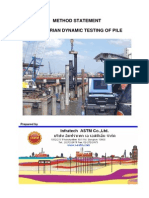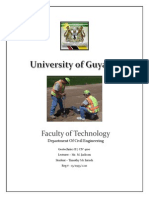In-House Work Procedure For Test: Qatar Engineering Laboratories
In-House Work Procedure For Test: Qatar Engineering Laboratories
Uploaded by
Raj MaCopyright:
Available Formats
In-House Work Procedure For Test: Qatar Engineering Laboratories
In-House Work Procedure For Test: Qatar Engineering Laboratories
Uploaded by
Raj MaOriginal Description:
Original Title
Copyright
Available Formats
Share this document
Did you find this document useful?
Is this content inappropriate?
Copyright:
Available Formats
In-House Work Procedure For Test: Qatar Engineering Laboratories
In-House Work Procedure For Test: Qatar Engineering Laboratories
Uploaded by
Raj MaCopyright:
Available Formats
Doc. Ref. No.
Issue No.
Date Issue
Rev. No:
Pages
IN-HOUSE WORK PROCEDURE FOR TEST
Authorized by
LOW STRAIN INTEGRITY TESTING OF CONCRETE PILES (ASTM D5882)
QATAR ENGINEERING LABORATORIES
A BKG HOLDING COMPANY
IWPT-222
01
10/04/2013
00
1 of 2
Babu Rajan K.G.
1. Purpose: This document is a simplified guide for technicians and laboratory workers. The following sections summarise the
key elements of the test method referred to in the title of this document. For complete details refer to the referenced
international specification.
P.I.T. Introduction
The Pile Integrity Tester (PIT) is a precision instrument and analysis system for pile shaft integrity testing by lowstrain methods. A small impact is administered to the piles surface, generally using a special hand-held
hammer, and an acoustic wave from the impact propagates down through the pile. Variations in the shape and
material quality of the pile produce reflections, which are observed as they returned to the surface. Surface
vibrations are recorded until all primary reflection has been observed. Reflections are then interpreted,
considering their nature and times of observation, to asses pile integrity. The reflections are observed by means
of an accelerometer temporarily mounted to the surface of the pile. The acceleration signal is digitized and
stored in the PIT Collectors memory. Usually it is numerically integrated to produce a velocity signal.
Preparation
The accelerometer and the hammer impact must be applied to a very clean and hard surface. Therefore, the
pile top surface must be properly prepared. Use a grinder or other tools as necessary to smooth uneven
surfaces and to remove contaminated or loose material where the accelerometer is to be attached and where
the pile is to be struck by the hammer. The accelerometer must be firmly affixed to the pile top in order to
measure the high-frequency motion of that surface during impact and reflection, the accelerometer should be
bonded to pile top. The pliable wax supplied with the equipment or petroleum jelly for cold weather. Other
adhesive materials such as plastic clay or bowl sealer wax can also be used. Attached the accelerometer to the
pile top using a thin layer of bonding material; a thick layer can distort the signal.
Hammer Technique
A stress wave generated by the hammer impact will only produce clear reflections if the impact has a sharp
onset and short duration. Therefore, the hammer tip should have a hard surface. However, if the signal is too
large or sharp, excessively high frequency component may distort the signal and make difficult to analyze. The
hammers supplied by instrument manufactures are chosen for their optimal performance. In general, a smaller
hammer imparts a higher-frequency impact pulse, so a smaller hammer is usually better. A larger hammer may
be more effective for longer piles with high friction. A proper hammer impact constitutes much of the art in pile
integrity testing.
The impact should not damage the pile top. If the pile is too hard, ringing may be observed in the response
signal; this should be avoided. A softer impact with a smoother signal is preferable if it produces sufficient
reflection from the bottom of the pile. If the signal is weak, try increasing the gain so as to amplify the signal and
Doc. Ref. No.
Issue No.
Date Issue
Rev. No:
Pages
IN-HOUSE WORK PROCEDURE FOR TEST
Authorized by
LOW STRAIN INTEGRITY TESTING OF CONCRETE PILES (ASTM D5882)
QATAR ENGINEERING LABORATORIES
A BKG HOLDING COMPANY
IWPT-222
01
10/04/2013
00
1 of 2
Babu Rajan K.G.
optimally utilize the instruments range and resolution. The best combination of all factors above results in the
best data, which in turn produce the most accurate interpretation.
Signal Collection
A velocity records from a perfect pile shaft exhibits the impact, followed by a flat response, until a reflection from
the toe is observed with a velocity profile similar to that of the impact event. In practice there is usually shaft
friction that shifts the velocity record negative after the initial impact, and reduces the magnitudes of later
reflections. To identify the location of a reflector the wave speed C must be accurately establish (C=4000 m/s,
typical value for concrete). If the pile toe is observed in a pile accurately known length, the wave speed may be
adjusted so that the toe reflection is displayed at the toe distance L. The toe reflection is often obscure in piles
with large or numerous impedance changes. Similarly, if the wave speed is known, the pile length may be
adjusted to align L with the toe reflection. The shaft length is often variable, particularly for drilled shafts. If the
pile has serious defect, a full crack, or a mechanical splice with an inherent gap between sections, the stress
wave might not pass this feature; then only the portion of the shaft above this location can be evaluated. Many
of the most serious defects are in the upper portion of the shaft. Deeper defects are often judged less serious if
the shaft resistance above the defect is adequate to bear the load. However, any major defect is always a cause
for concern. To help reveal local defects near the top of a large-diameter pile, several locations around the
perimeter and center should be tested.
Reprocessing, Reporting and Archiving
Once the data are collected, they should be analyzed thoughtfully using the PIT Collectors reprocessing and
signal enhancement facilities; plots should be made of all records and should be included in the report. The PIT
Collectors acquires and stores data on a temporary basis. For archiving and optional further processing, data
should be transferred to a computer running the PIT program, and stored on other medium suitable for
archiving. The PIT program may be used on the PC to examine files and reprocess PIT Collector data. It also
supports more elaborate features.
Interpretation
It should be clearly understood that the main purpose of this test is to locate piles with serious defects. Minor
defects could easily be missed (and may not be important anyway to overall load carrying performance of the
pile shaft as the soil resistance is usually the limiting factor in the pile capacity). Since this method is
inexpensive, it is feasible to test all piles on a given site. The test can be specified after installation is complete
as it does require access tubes or other advance planning. The major purpose of any integrity test is the
investigation for potential major defects in the shaft.
Although the acceleration curve could be interpreted directly, integration to velocity generally enhances the
record by bringing out details otherwise overlooked.
You might also like
- Manaul of Au3tech System Laser SuduraDocument30 pagesManaul of Au3tech System Laser Suduramarius vasile0% (1)
- SMART VocabularyDocument49 pagesSMART VocabularyNidraf Gaming0% (1)
- Standard Method statement-PITDocument4 pagesStandard Method statement-PITmahesh naikNo ratings yet
- Method Statement For Pile Integrity Test ProcedureDocument3 pagesMethod Statement For Pile Integrity Test ProcedureDeny Cahyo N100% (2)
- Method Statement For PIT TestDocument4 pagesMethod Statement For PIT TestArifur Rahman Apu100% (2)
- STANDARD TEST METHOD PIT (Pile Integrity Test)Document5 pagesSTANDARD TEST METHOD PIT (Pile Integrity Test)senthilNo ratings yet
- P21 CH 283 (Pit)Document8 pagesP21 CH 283 (Pit)reportNo ratings yet
- How To Perform Low Strain Pile Integrity TestDocument6 pagesHow To Perform Low Strain Pile Integrity TestAamirShabbirNo ratings yet
- Low Strain Pile Integrity TestingDocument6 pagesLow Strain Pile Integrity TestingWaqas SadiqNo ratings yet
- Pit Report Pier04 Pile01 06Document11 pagesPit Report Pier04 Pile01 06Priodeep ChowdhuryNo ratings yet
- TH2 5Document15 pagesTH2 5Hoang Ha NguyenNo ratings yet
- SMD 12-p3r CH 226 PitDocument7 pagesSMD 12-p3r CH 226 PitreportNo ratings yet
- SIT PPT by GeosearchDocument23 pagesSIT PPT by GeosearchMuhammad AliNo ratings yet
- Pile Integrity Final Report: Test Report No. KRL-42400-TR-461062 Test Report Date 08/02/2022Document6 pagesPile Integrity Final Report: Test Report No. KRL-42400-TR-461062 Test Report Date 08/02/2022Sabyasachi BangalNo ratings yet
- OP-016. Procedure For Pile Integrity Test (Pit) : Work Instructions For EngineersDocument0 pagesOP-016. Procedure For Pile Integrity Test (Pit) : Work Instructions For EngineersLasantha DadallageNo ratings yet
- PDA Methodology Kohelia BridgeDocument10 pagesPDA Methodology Kohelia Bridgembp planningNo ratings yet
- Gearbox White PaperDocument13 pagesGearbox White PaperRony MartínezNo ratings yet
- 12.07.2021 Pit Full ReportDocument10 pages12.07.2021 Pit Full ReportJulius GuingabNo ratings yet
- Pit E103 11Document13 pagesPit E103 11PLANiN Innovation & Consultancy Services Pvt. Ltd.No ratings yet
- Methodology For Dynamic Load Test On R.C.C. Cast-In-Situ Bored PilesDocument9 pagesMethodology For Dynamic Load Test On R.C.C. Cast-In-Situ Bored PilesmdNo ratings yet
- Method Statement For Pile Integrity Test ProcedureDocument3 pagesMethod Statement For Pile Integrity Test ProcedureDharma Pratap Lamgade100% (1)
- Integrity Test of PileDocument5 pagesIntegrity Test of PileDae Yeol KimNo ratings yet
- Foundation Testing Data Sheet 1 Pile Integrity Testing - TDR MethodDocument5 pagesFoundation Testing Data Sheet 1 Pile Integrity Testing - TDR MethodNishit PatelNo ratings yet
- Electronic Tap Hammer For Composite Damage AssessmentDocument9 pagesElectronic Tap Hammer For Composite Damage AssessmentBilal AhmadNo ratings yet
- Method Statement Dynamic Load TestDocument14 pagesMethod Statement Dynamic Load TestmarcvenzNo ratings yet
- Non Destructive Testing ReportDocument19 pagesNon Destructive Testing ReportAbdul Rahman HilmiNo ratings yet
- Sample Specification For Pile Integrity Testing by The Low Strain MethodDocument2 pagesSample Specification For Pile Integrity Testing by The Low Strain Methodjfsianturi1No ratings yet
- Pec Basics v9 PDFDocument8 pagesPec Basics v9 PDFWayneNo ratings yet
- 4 Ver 2 Pulse Eddy CurrentDocument8 pages4 Ver 2 Pulse Eddy CurrentMuhammad Zariq100% (1)
- Spek PIT TestDocument3 pagesSpek PIT TestAgung RizkyNo ratings yet
- Vibration MonitoringDocument9 pagesVibration Monitoringelbusharieltaher1261No ratings yet
- 036 PEC ArticleDocument7 pages036 PEC Articlemahesh070100% (1)
- Sample Specification For Pile Integrity Testing by The Low Strain Impact MethodDocument3 pagesSample Specification For Pile Integrity Testing by The Low Strain Impact MethodSEKAR KNo ratings yet
- Dynamic Pile TestingDocument4 pagesDynamic Pile Testinglaikienfui100% (2)
- Ut Proceduregeneral 141118232235 Conversion Gate02Document24 pagesUt Proceduregeneral 141118232235 Conversion Gate02Danem HalasNo ratings yet
- Technical - Document For PilingDocument5 pagesTechnical - Document For PilingSheikh Nouman Mohsin RamziNo ratings yet
- Method Statement - Test PilingDocument5 pagesMethod Statement - Test PilingMcr Kumara0% (1)
- CIV 4100 Assignment No3Document13 pagesCIV 4100 Assignment No3tamooseNo ratings yet
- TG1 Scala Dynamic Cone Penetrometer Cone CalibrationDocument4 pagesTG1 Scala Dynamic Cone Penetrometer Cone Calibrationanthony100% (1)
- SPE/IADC-173037-MS Recent Advances in Soft Torque Rotary SystemsDocument12 pagesSPE/IADC-173037-MS Recent Advances in Soft Torque Rotary SystemsGreg CerrutiNo ratings yet
- Pile Intigrity TestDocument7 pagesPile Intigrity TestimranNo ratings yet
- Cement Evaluation and Casing Integrity Analysis of Well Using Cement BondDocument10 pagesCement Evaluation and Casing Integrity Analysis of Well Using Cement BondM JahangirNo ratings yet
- Methodology - Dyanmic Load TestDocument5 pagesMethodology - Dyanmic Load Testgaukum290No ratings yet
- Method Statement PDA-2011Document19 pagesMethod Statement PDA-2011Muhunthan Murugananthan100% (15)
- SPE/IADC 52836 On-Line Torque & Drag: A Real-Time Drilling Performance Optimization ToolDocument10 pagesSPE/IADC 52836 On-Line Torque & Drag: A Real-Time Drilling Performance Optimization ToolfzpvhkgkfjNo ratings yet
- CBT - CetDocument4 pagesCBT - CetWael FaragNo ratings yet
- Prodcution LoggingDocument22 pagesProdcution LoggingAarzoo JobanputraNo ratings yet
- UT 0030 Thickness Measurement Surveys PDFDocument15 pagesUT 0030 Thickness Measurement Surveys PDFAhmed Ben Nouma0% (1)
- OP-016. Procedure For Pile Integrity Test (Pit) : Work Instructions For EngineersDocument8 pagesOP-016. Procedure For Pile Integrity Test (Pit) : Work Instructions For Engineersjinwook75No ratings yet
- Petrophysics and Pore Pressure-Pitfalls and PerfectionDocument28 pagesPetrophysics and Pore Pressure-Pitfalls and PerfectionbagcivanyildizNo ratings yet
- PDA Testing ResultsDocument33 pagesPDA Testing Resultspatricklim1982100% (2)
- Phased Array and ToFD - V - Radiography PDFDocument14 pagesPhased Array and ToFD - V - Radiography PDFdarouich100% (1)
- PAUT - Phased Array and ToFD - V - Radiography PDFDocument14 pagesPAUT - Phased Array and ToFD - V - Radiography PDFdarouich100% (1)
- AGES - Method Statement For PDADocument8 pagesAGES - Method Statement For PDAResearcherNo ratings yet
- TOFDDocument14 pagesTOFDaliextoma100% (1)
- Is 14893 2001Document14 pagesIs 14893 2001Ashokan KelothNo ratings yet
- The Application of Vibration SignatureDocument9 pagesThe Application of Vibration SignaturePhong Lê ĐìnhNo ratings yet
- Sample PIT Report - FINALDocument21 pagesSample PIT Report - FINALSaid MendozaNo ratings yet
- sample-specification-for-Pile-Integrity-Testing-by-the-Low-Strain-Method-PDIDocument2 pagessample-specification-for-Pile-Integrity-Testing-by-the-Low-Strain-Method-PDIsebastian titusNo ratings yet
- In - Situ Soil AnalysisDocument9 pagesIn - Situ Soil AnalysisNthome ShadrackNo ratings yet
- Lifting TrainingDocument9 pagesLifting TrainingMohamed OmarNo ratings yet
- Estimator's Piping Man-hours Tool: Estimating Man-hours for Carbon Steel Process Piping Projects. Manual of Man-hours, ExamplesFrom EverandEstimator's Piping Man-hours Tool: Estimating Man-hours for Carbon Steel Process Piping Projects. Manual of Man-hours, ExamplesNo ratings yet
- Calculation For Water Pressure TestingDocument7 pagesCalculation For Water Pressure TestingRaj MaNo ratings yet
- UPDA PrecedureDocument2 pagesUPDA PrecedureRaj Ma100% (1)
- Draft Prospectus For MG University CAPDocument121 pagesDraft Prospectus For MG University CAPRaj MaNo ratings yet
- D I Pipes, Fittings and AccessoriesDocument36 pagesD I Pipes, Fittings and AccessoriesRaj MaNo ratings yet
- An Intro To Water Supply SystemsDocument81 pagesAn Intro To Water Supply SystemsRaj MaNo ratings yet
- Section 14 2006 FormworkDocument18 pagesSection 14 2006 FormworkRaj MaNo ratings yet
- 5 FingersDocument1 page5 FingersRaj MaNo ratings yet
- BPNTC - Activity InternetDocument2 pagesBPNTC - Activity InternetchelseaNo ratings yet
- Business Communication: Project by Krishna Yadav B-22Document15 pagesBusiness Communication: Project by Krishna Yadav B-22Krishna YadavNo ratings yet
- ECEE 401-IntroToVLSIDocument8 pagesECEE 401-IntroToVLSIChristiensen ArandillaNo ratings yet
- Allahabad High Court RO Official Paper (Held On - 10 Dec, 2021 Shift 1)Document76 pagesAllahabad High Court RO Official Paper (Held On - 10 Dec, 2021 Shift 1)ankurmmmec109No ratings yet
- Yunas Metal WorksDocument23 pagesYunas Metal WorksAwais HassanNo ratings yet
- ĐỀ CƯƠNG TIẾNG ANH 2Document22 pagesĐỀ CƯƠNG TIẾNG ANH 2Lương Thanh TùngNo ratings yet
- Hi-Lo Breakout Strategy: Chapter OneDocument9 pagesHi-Lo Breakout Strategy: Chapter OneNo NameNo ratings yet
- MTAP 2005 Grade IDocument3 pagesMTAP 2005 Grade Ijunald31100% (3)
- PARACETAMOL. sALINASE. FLUIMUCILDocument2 pagesPARACETAMOL. sALINASE. FLUIMUCILfed08No ratings yet
- Parts Catalog: This Catalog Gives The Numbers and Names of Parts On This MachineDocument39 pagesParts Catalog: This Catalog Gives The Numbers and Names of Parts On This MachinePericoNo ratings yet
- Green Bill: Scan & PayDocument6 pagesGreen Bill: Scan & Paymohamed elmakhzniNo ratings yet
- Wallkill Hose Company Audit ReportDocument19 pagesWallkill Hose Company Audit ReportDaily FreemanNo ratings yet
- Emerging and Reemerging Infectious DiseasesDocument13 pagesEmerging and Reemerging Infectious DiseasesSayu100% (1)
- Soal Kls11 B Ing Uts 20182019Document2 pagesSoal Kls11 B Ing Uts 20182019Dwi YuniwatiNo ratings yet
- Efb Jaa ApprovalDocument56 pagesEfb Jaa ApprovalshotguntigerNo ratings yet
- Aerodynamics 2 Exam #4Document8 pagesAerodynamics 2 Exam #4Kisna Bhurtel100% (1)
- Muhammad Muqrrab: Education SkillsDocument1 pageMuhammad Muqrrab: Education Skillsmuqrrab2100% (1)
- Capacities of UB SectionsDocument48 pagesCapacities of UB SectionsRohan KarandeNo ratings yet
- (2024) Enhancing The Flexural Performance of Concrete Beams With 3d-Printed UHP-SHCC Permanent Formwork Via Graded Fiber Volume FractionDocument12 pages(2024) Enhancing The Flexural Performance of Concrete Beams With 3d-Printed UHP-SHCC Permanent Formwork Via Graded Fiber Volume FractionDr.Nawaf AlotaibiNo ratings yet
- Brian Walker: Work ExperienceDocument3 pagesBrian Walker: Work ExperiencetransNo ratings yet
- Mycube Week One Sales Riley BuchsDocument16 pagesMycube Week One Sales Riley Buchsapi-358936842No ratings yet
- De Jesus vs. The City of ManilaDocument2 pagesDe Jesus vs. The City of ManilaCarissa Cruz100% (1)
- 2014 Calculus AB Free Response Questions (Answers and Explanations)Document7 pages2014 Calculus AB Free Response Questions (Answers and Explanations)eric100% (1)
- Traffic Bifurcation Between DPDK and Linux Kernel Using DPDMUXDocument9 pagesTraffic Bifurcation Between DPDK and Linux Kernel Using DPDMUXpuny potNo ratings yet
- Anheuser Busch Case Study On CSRDocument11 pagesAnheuser Busch Case Study On CSRgloriaandjessicaNo ratings yet
- Basic Manners For Dogs - Manual de Dresaj CaninDocument26 pagesBasic Manners For Dogs - Manual de Dresaj CaniniuliaoanadNo ratings yet
- Finance Module 10 Managing Personal FinanceDocument4 pagesFinance Module 10 Managing Personal FinanceKJ JonesNo ratings yet
- Module 1 QMS ConceptsDocument56 pagesModule 1 QMS ConceptsCarlos FilipeNo ratings yet
































































































